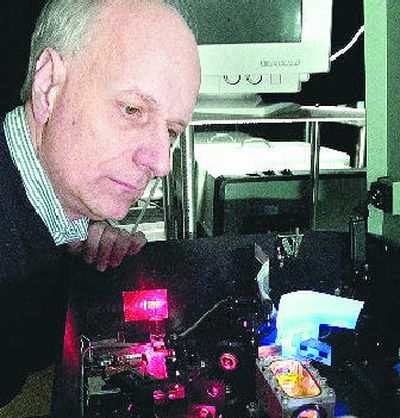WSU physicist helps create quantum leap in fiber optics

A Washington State University researcher may have helped in a scientific advance that could radically speed up the operation of computers, Internet connections, medical technology and a host of other systems.
Mark Kuzyk, a professor of physics and astronomy at WSU, and his colleagues have found a molecule that reacts to light more strongly than any other measured. It’s a promising development in the field of optics, suggesting the possibility of much smaller, faster and more efficient light-powered systems that might someday replace a wide range of electronic systems.
A fellow researcher in the subject, Geoff Lindsay of the U.S. Navy Research Department, calls it “the greatest advance … since the field began.”
Kuzyk and his colleagues at WSU have long studied the types of molecules that might respond most strongly to light – a responsiveness that is key to creating optical switches to direct and organize information stored as pulses of light in optical fibers. Such switches could someday replace relatively inefficient electrical transfers used to direct information in wiring systems now, Kuzyk said.
The molecules, called chromophores, were made by chemists in China, evaluated against calculations by Kuzyk, and tested by chemists in Belgium. The results of the work were published this month in the journal Optics Letters.
The most important characteristic of the chromophores is the way the molecules deflect light.
Most materials in the world bend light in a consistent manner – the angle of deflection is the same no matter how bright the light.
But these molecules change as the light gets brighter, becoming deformed and bending the light at different angles. Such “nonlinear” molecules offer hope for creating ways of switching light within optical fiber systems, though developing the materials and systems to use the molecules will take a lot of time.
“There are so many potential applications,” Kuzyk said.
The reason the new molecule works so much better is based on quantum mechanics and the strange way that matter behaves on the subatomic level.
“Quantum mechanics is a very eerie subject, because it tells you such strange things are happening,” Kuzyk said.
One of those strange things is that electrons exist as waves – and actually, as waves that co-exist in different points of space at the same time – rather than as single points in space. Because of that, electron waves actually interfere with themselves.
However, if a molecule is designed with a structure that actually included some “speed bumps,” Kuzyk said, it would corral the electrons a bit and limit that interference.
Kuzyk said that scientists will now try to develop a molecule with even more speed bumps.
Ideally, a molecule would be developed that would react more strongly to dimmer light.